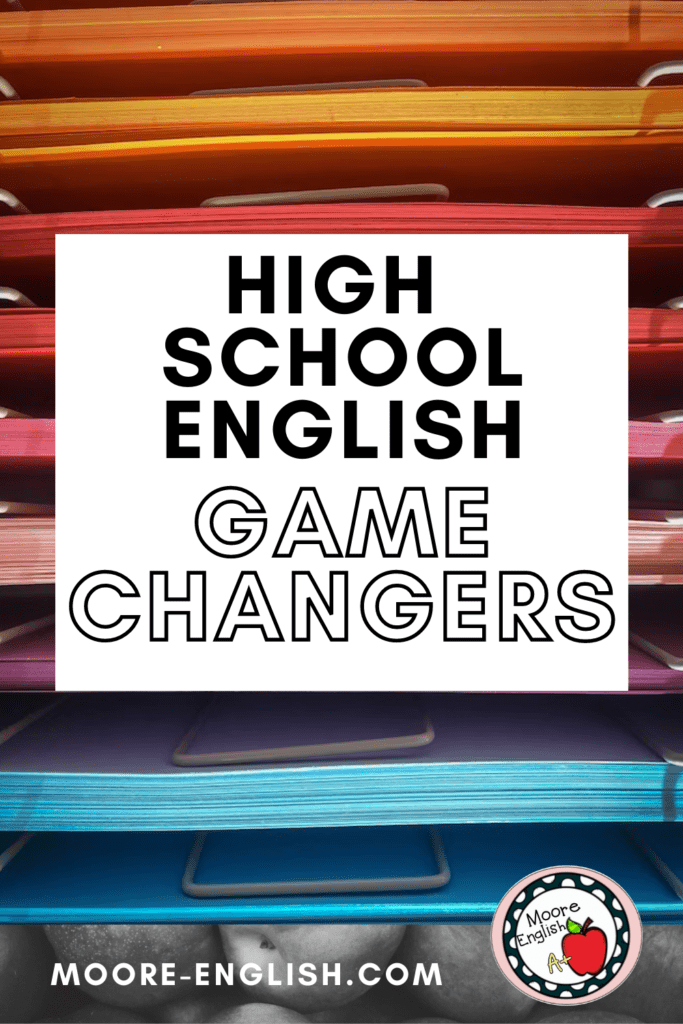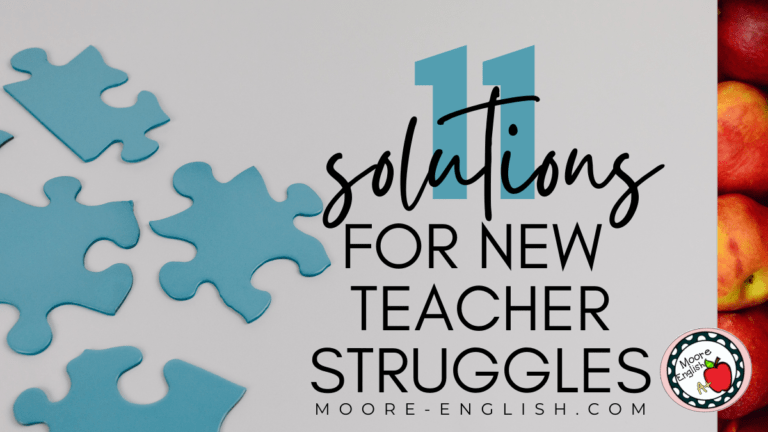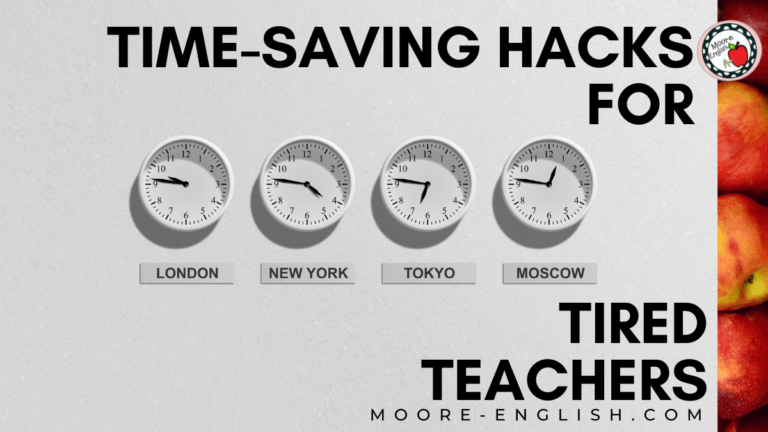Trends and fads are part of education. As a new teacher, it can be hard to know when to keep the course and when to jump on the bandwagon. After ten years of teaching, I am skeptical of bells and whistles. I can sniff out a new buzzword from a mile away. And I scrutinize everything.
In addition to being discerning (or, depending on who you ask, crabby), I am a type-A overthinker. As the Queen of Over Analyzing, I think through every recommendation I share before I post it online. In the past, I have scrapped completed posts or resources because they are too gimmicky.
So when I share these game changers, I mean it. These are ideas, strategies, and resources that have transformed my classroom. Should you implement them all at once? No, try the solutions that solve problems in your classroom.
This post this post may contain affiliate links. Please read the Terms of Use.
Organizational Game Changers
Regardless of your classroom experience, organization is a key part of classroom management. For me, choosing classroom procedures that work for me (rather than looked cute) is a game changer. Simplifying processes and keeping them consistent is also part of keeping a classroom progressing. These four organizational tools and tricks are absolute game changers (and most of them are free).
- First, a Very Basic Agenda Slide helps with communication and expectation. My free agenda slides do not have any bells and whistles, but they help students understand upcoming deadlines. This is also an easy way to streamline absent work.
- Additionally, seating charts don’t cost anything, but they are game changers. As a new teacher, I thought free seats made me seem cool and “with it.” Um…no, free seats just made me seem unprepared and communicated to students that I had low expectations. A good seating chart should reinforce expectations and simplify procedures.
- Similarly, an easy-to-use Parent Contact Log is key. Over the years, I’ve tried every parent-contact log: cute paper records and detailed documents. However, this editable Google Form is the quickest, easiest option. All the information collects in a Google Sheet that I can quickly sort, search, and share with counselors and administrators.
- Last year, I leveled up my classroom library by adding genre labels. This was a time-consuming process, but it has made my library easier for students to navigate. As a result, students check out more books! I made my labels in Canva; you can check them out today.
Engagement Strategies
Classroom engagement is a perennial topic of conversation. How do teachers keep students focused and motivated to learn without watering down the content or losing sleep building extravagant lessons? In the last few years, these resources have been game changers when it comes to student engagement.
- First, bell work is a treasured classroom procedure. Bell work is as much about organization and structure as it is about content. To make bell work more engaging, I often use visual writing prompts. Sometimes I’m focused on a particular skill, but oftentimes I simply want students to practice on-demand writing. I even have seasonal images to keep students engaged all year!
- Secondly, I love a good Ted-ed or Crash Course video to introduce or review content. Because these clips can be short, sometimes they move fast. Listening guides have been game changers for me. They can be on paper, in Google Classroom, or in Google Jamboard. Whichever way you implement listening guides, they are a great way to engage students and focus their thinking. Grab my favorite listening guides today!
- Similarly, a silent discussion is a great way to help students process their learning. Engaging with Big Ideas is a good way to motivate students, too. To help all students feel comfortable with classroom discussion, I often use this editable silent discussion template.
- Finally, movement is my favorite way to engage students. Stations can be such a simple way to incorporate structured, meaningful movement. These literary analysis stations are game changers for me because they’re flexible, ready-to-use, and high-interest for all learners.
Instructional Game Changers
As a teacher, curriculum and instruction are near and dear to my heart. More than anything, this love led me to create Moore English. As a result, I have found some instructional game changers that I always want to share.
- If you take nothing else from this post, please take this: Stop using P-I-E to teach author’s purpose, and switch to using R-E-C-E-I-P-T. This is a more nuanced way to level up your instruction. This is one of those game changers I keep talking about because it has made such a difference for my students. Grab my anchor charts today!
- Another instructional game changer has been implementing a clear cut process for making revisions. My students can be grade-focused, but I am learning and growth-focused. For this reason, I am a huge advocate of allowing students to make revisions to their work. This free test corrections sheet is how I streamline and organize that process.
- A few years ago, I taught freshmen for the first time in years. Knowing that I would have to bring my A-game to this class, I created a series of grammar and vocabulary games. These games have been game changers because they are flexible. They can be bell work, intervention, enrichment, and test prep. Last summer, I gave them a makeover, so they’re more comprehensive than ever. Check them out today!
- Similarly, introducing task cards has been an excellent instructional upgrade. While I was once intimidated by task cards, now I love their flexibility. In particular, I appreciate being able to “stack the deck” as a way of differentiating instruction for learners of all skill levels. Check out my favorite task cards!
Differentiation Strategies
Differentiation is an area in which I am always growing. For one, I feel like my ability to adjust in the moment has improved over the years, and the pivot is always going to be a key part of successful differentiation. However, differentiation is also intentional, so I’m always planning for ways to reach all my students. In the past few years, I have become more and more comfortable offering students abridged texts. These five have been particular successes for me:
- First, Beowulf was one of the first long works I ever taught, and I hated it. Students were bored or confused, and I struggled to help them make meaningful connections. After years of reflection, I understood their apathy: our textbook version was too easy for some and mystifying for others. For this reason, I created three leveled versions of the text for beginner, intermediate, and advanced readers. These three options have been true game changers!
- Similarly, the short stories Berenice and To Build a Fire are classics. They are both wild enough to engage most students, but they’re both long texts. Abridging the texts makes them more manageable and also allows me to include guiding questions and helpful text features.
- Likewise, The Rime of the Ancient Mariner is one of those texts students may have encountered without really knowing it. Many of them have heard a song about an albatross or heard an idiom about an albatross without knowing much about the allusion. As a child, one of my nursery rhyme books began with “Water, water everywhere…,” but it was ages before I understood the reference. Making this poem accessible to all learners provides more students with a chance to engage this text.
- Finally, Shakespeare is the poster child for abridging and modifying texts. While I find the language of Julius Caesar beautiful and affecting, students are often stumped. Rather than letting them turn blindly to online tools (some of which are not quite what I want), I prefer to abridge and modify the text. Everyone knows the story of Romeo and Juliet, but with some modifications, everyone can also enjoy reading the play.














